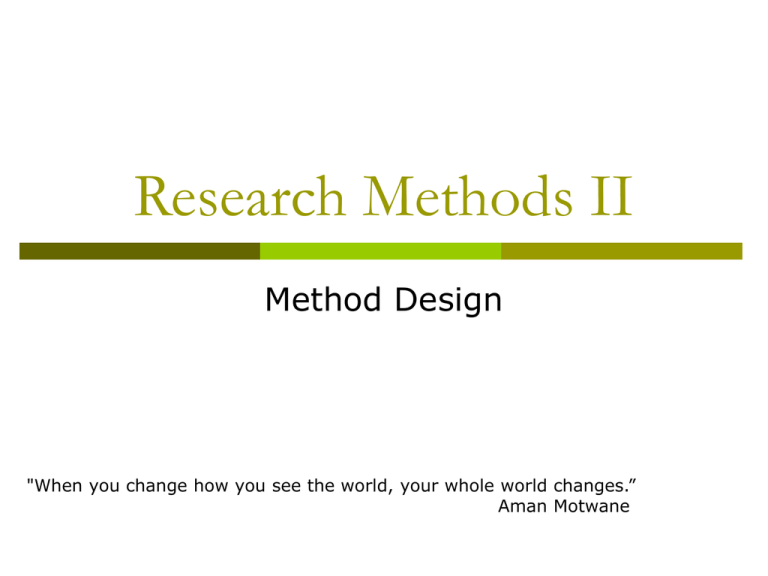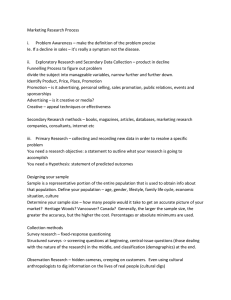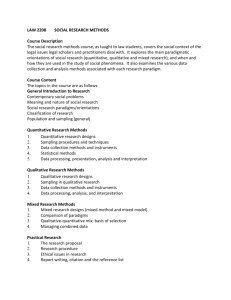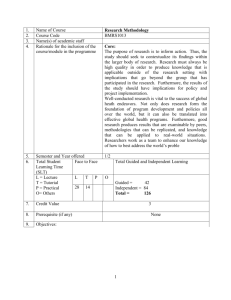Research Methods 2 Design
advertisement

Research Methods II Method Design "When you change how you see the world, your whole world changes.” Aman Motwane Game Plan Designing your research Collecting Data Quantitative Qualitative Primary and Secondary Data Sampling Measurement Qualitative Data Collection Interviews Surveys Observation Method design in the thesis process Formulate and clarify your research question Chapter 1 Review the Literature/Theory Chapter 2 Formulate your research design Chapter 3 Answering research question Sampling Measurement Analyze your data Chapter 4 Qualitative Methods Quantitative Methods Write your Results and Discussion Chapter 5 The methods process Research Design How are research questions answered? Ex: A mixed method study investigating the relationship between cultural acuity and practitioner effectiveness Data Collection / Sampling / Setting/ Who did you study and how did you select them? Ex: Population is all employees of Intel – sample is Finance Department Measurement How are numbers assigned to concepts? Ex: Quality of Work Life – measured by the QOL index Data Analysis How are data manipulated and interpreted? Ex: Regression Analysis Alternative Research Designs Creswell (2003) Quantitative research Qualitative research Mixed methods research Experimental designs Non-experimental designs, such as surveys Predetermined Instrument based questions Performance data, attitude data, observational data and census data Statistical analysis Study is exploratory Case studies Ethnographies Emerging methods Open-ended questions Interview data Observation data Document data Audiovisual data Text and image analysis Elaborate and expand findings of one method with another Concurrent – converge quantitative and qualitative data Both predetermined and emerging methods Both open-ended and closed-ended questions Multiple forms of data drawing on all possibilities Statistical and text analysis Your design will drive your data collection The Research Onion Techniques and procedures Time horizons Choices Strategies Approaches Philosophies Positivism Realism Data collection and data analysis Interpretivism Deductive Experiment Survey Objectivism Case CrossMono-method studyAction Subjectivism sectional research Mixed methods Grounded Multi-method Longitudinal Pragmatism Ethnography Archival research Constructivism theory Inductive Functionalist Interpretive Radical humanist Positivism versus Constructionism Constructionism Knowledge is subjective It’s the product of the context in which its constructed (ex. Copernicus) Scientific knowledge is not a “direct representation of the natural world” It’s based on systems of thought that are culturally and historically bound Positivism All knowledge is derived from experience whether of the mind or of the senses. Evidence by what we can see, hear, touch, taste, or smell Is the basis of “The Scientific Method” Emphasizes the importance of testability, reliability, validity, and repeatability Asserts that the researcher is “bias-free” Claims “objectivity” Your theoretical perspective leads to your research design Qualitative vs Quantitative Design Quantitative Tests or verifies theories or explanations Identifies variables to study Relates variables Observes and measures information numerically Uses unbiased approaches Uses statistical procedures Largely deductive reasoning Qualitative Takes place in the natural setting Uses multiple methods that are interactive and humanistic Is emergent Fundamentally interpretive Researcher views social phenomena holistically Researcher reflects on who he or she is in the inquiry and is sensitive to how that shapes the study Largely inductive reasoning Collecting Primary Data Survey Research Interviews Observation Methods Experimental Research Collecting Secondary Data Consider who would have collected data Governments, NGOs, Association or interest group etc Good Sources Statistical Universe Statistical Abstracts Historical Statistics WDI – World Development Indicators IMF – International Financial Statistics United Nations – UN Stat Economic Report of the President Historical tables Secondary data: data that has been collected for some other purpose Sampling: who AND how many to ask when you can’t study the entire population You are conducting a study of professional success factors among CC alumni who are external consultants. What is your best approach? Two key questions: Sampling is often a major limitation Is the sample biased? Is the size adequate? Failure to identify the population, sample of convenience, volunteerism, Sample size – bigger is not always better – “it all depends…” Sampling Techniques Sampling Probability Simple Random Non-Probability Stratified Random Systematic Quota Cluster Snowball Purposive Convenience Self-Selection Your goal is to produce valid and credible sample data and statistics that match the precision needed for the study Probabilistic Sampling Simple Random: every member of the population has an equal probability of being sampled (use random # tables) Systematic Sampling: select at intervals (e.g,. Starting at 18, every 50th listing is selected) Stratified Sampling: grouping the study population into strata and selecting a random sample within each stratum (e.g., dividing the population by education – less than high school, high school, no college diploma, college diploma, then selecting a random sample) Cluster: random selection of groupings from which all members are chosen for the sample (e.g., geographic groupings, intact groups) Multi-stage: select a cluster, then sampling members of the selected clusters Non-probability Non-probabilisticSamples Sampling Quota: ensures that certain characteristics of a population sample will be represented (e.g., need 20 small business owners, 10 minority, etc.) Purposive: (Judgment) experienced individual selects sample based on judgment about particular characteristics (e.g,. Political polls) Snowball: initial respondents are asked who else would be appropriate for the study Self-Selection: participants self-select into the study Convenience: selecting people (units) who are most conveniently available (e.g., college professor using students) How many interviews, surveys? It all depends Survey Research Question Variance of the population Minimum of 30 for most statistical tests More is better – to a point! Interviews Ask until you start to get repetition Remember – the intent in qualitative research is not to generalize, but to elucidate the particular, the specific Measurement: Variable DV: IV: IV: IV: Variable definition Conceptual Definition (include source) Operational Definition required for measurement (include source where appropriate) Measurement: Research questions and variables Q1: What is the relationship between faculty sleep deprivation and clarity of faculty communication in a thesis workshop? Dependent variable => clarity of communication Independent variable => sleep deprivation Q2: What is the relationship between clarity of faculty communication and student learning during a thesis workshop? Dependent variable => student learning Independent variable => clarity of communication Faculty sleep deprivation, communication clarity and student learning Variable Conceptual Definition (include source) Operational Definition required for measurement (include source where appropriate) Clarity of faculty communication Faculty stays on topic, uses appropriate examples, invites and answers questions – what, how, who, when and where Content analysis of lecture Sleep deprivation Number of nights over a one week period where sleep falls below 5 hours a night # of hours of sleep per night Faculty knowledge of subject matter (moderating variable) Demonstrated level of skill, ability and experience with subject matter # years experience, Education Student learning Degree to which students demonstrate the ability to apply concepts from the workshop to their project Application of concepts in projects (content analysis) Measuring Variables: Scale construction Scale – any measuring instrument (questionnaire, interview, test) composed of one or more items (questions, observations, etc…) that have logical relationships with one another. Standardized measures – don’t reinvent the wheel. Source for standardized measures – If you have to create your own Journal articles, books, other thesis or dissertation projects KISS Measure twice and cut once… the value of beta testing your approach Scale Example: Job Characteristics Hackman and Oldham, 1975 Measures the degree to which a job is designed to be motivating (the motivating potential of a job) Five dimensions: skill variety, task identity, task significance, autonomy and feedback My job requires me to use a variety of skills. My job allows me to see the finished products of my work. Doing my job well affects others in some important way. My job is designed so that I know when I have performed well. My job allows me freedom to work with minimum supervision. Scale Examples Participation/Involvement Scale I feel free to suggest new and better ways of doing things. I am asked how we can improve the way my work group operates. Sufficient effort is made to get the opinions and ideas of people in this work unit. Suggestions made by unit personnel are implemented in our daily work activities. Satisfaction In general, I am satisfied with my job. I have a sense of personal fulfillment at the end of the day. I am a valued member of my unit. I would recommend an assignment in my unit to a friend. Validity and Reliability Validity – does it measure what it is supposed to measure? Many types of validity that you need to consider Reliability – is it consistent? Increase reliability by: Sample size Multiple items Multiple raters Multiple measures Qualitative Data Collection Interviews Surveys Documents Audiovisual materials Observations Surveys / Interviews Interviews Telephone Interviews Group Interviews/ Focus Groups Self-Administered Questionnaires Mail, Fax, Internet Survey Monkey Interview Question Design: Good Questions Sound conversational Use words participants would use Are easy to say Are clear Are short Are open-ended Are one-dimensional Question Design: Probing Questions How do you mean that? Would you give me an example of what you mean? Tell me more about that… I don’t understand Anything else? Example of a Questioning Route Opening Questions Introductory Questions Transition Questions Key Questions Ending Questions Other questioning techniques Listing things Rating things Picture sort Drawing a picture Questioning Pitfalls Avoid asking “why”? Can put respondents on the defensive Be cautious about giving examples Double-barreled questions Abbreviations / Jargon / Slang Double-negatives Interview template •Discusses setting •Transcribes interview •Adds reflection notes where appropriate Designing Questionnaires/Surveys Survey Monkey Zoomerang InstantSurvey CC has a Survey Monkey account. See Library for account name and password. Major Decisions in Questionnaire Design What should be asked? How should each question be phrased? In what sequence should the questions be arranged? What questionnaire layout will best serve the research objectives? How should the questionnaire be pretested? A survey is only as good as the questions it asks Phrasing Questions Simple-Dichotomy Determinant Choice Frequency determination Attitude rating scale Checklist Observational Studies What can be observed? Human behavior and action Verbal behavior Expressive behavior Spatial relations Temporal patterns Physical objects Observational Studies Content of Field Notes Space Actor Act Activity Objects Time Goal Feeling Observation Field notes Observation Exercise Partner with someone in class Decide on what you could observe to answer a question about the CC experience Go to the place for 5 minutes Observe and take notes For purposes of this exercise, please do not disturb other classes 2 people can go into room 117 or room 128if you would like to observe a classroom Observation Follow-up General comments Most challenging? awkward? Easy to record? Impact of observer How could you manage that? Documents E-mails, Letters, Memos, reports and minutes of committees Annual reports Could ask participants to keep journals (case studies and narrative research) Administration No class tomorrow – Aju and I will be available to meet with you (Julie after 10:30) Research Question presentation Monday. Please bring your presentation on a memory stick.






